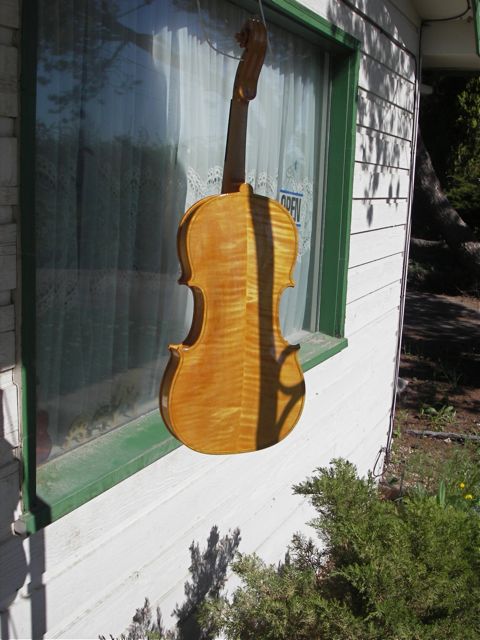
I applied the first coat of varnish to a 'white' violin this morning. The varnish is some that we made last month, and when I say "we made" I mainly mean that I sat around and watched while Ruston did all the work. But it is pretty cool stuff and I hope it works out. This is much different than other varnish I've worked with -- the rest of that being commercial violin and spar varnish. This is like a thick syrup. I put it on with my fingers, patted it around, leaving fingerprints and such, but after several minutes, all that flowed out. It dries to the touch within a few hours when exposed to sunlight, though will stay tacky for a couple days if left inside. I've done experiments with sample strips of wood.
This is the first violin I've varnished with it, but it is not a violin I built. It is an inexpensive 'white' violin, meaning it was built but not finished. I had wanted a second-level instrument, but Howard Core was out of those, so we substituted for a bottom-tier instrument. I asked for something with interesting figure on the back, and I think they did a good job picking one out for me.
This has my usual tea stain followed by watered-down amber shellac for the ground. Trying to be like the old-time Cremonese, I hung this outside shortly after varnishing. It promptly attracted a floating dandelion seed, but that will come out easy enough when I buff it down later. And there will be a couple more coats of varnish to go, so more chance for floating debris. It's all organic!

Very nice Mr. Pollard
ReplyDeleteThank you kindly, Mr. Shepherd.
ReplyDeleteFor other readers, keep an eye out for Stephen's new book, "Shellac, Linseed Oil and Paint, Traditional 19th Century Woodwork Finishes" which includes a section on varnish. His blog as at http://www.fullchisel.com/blog/